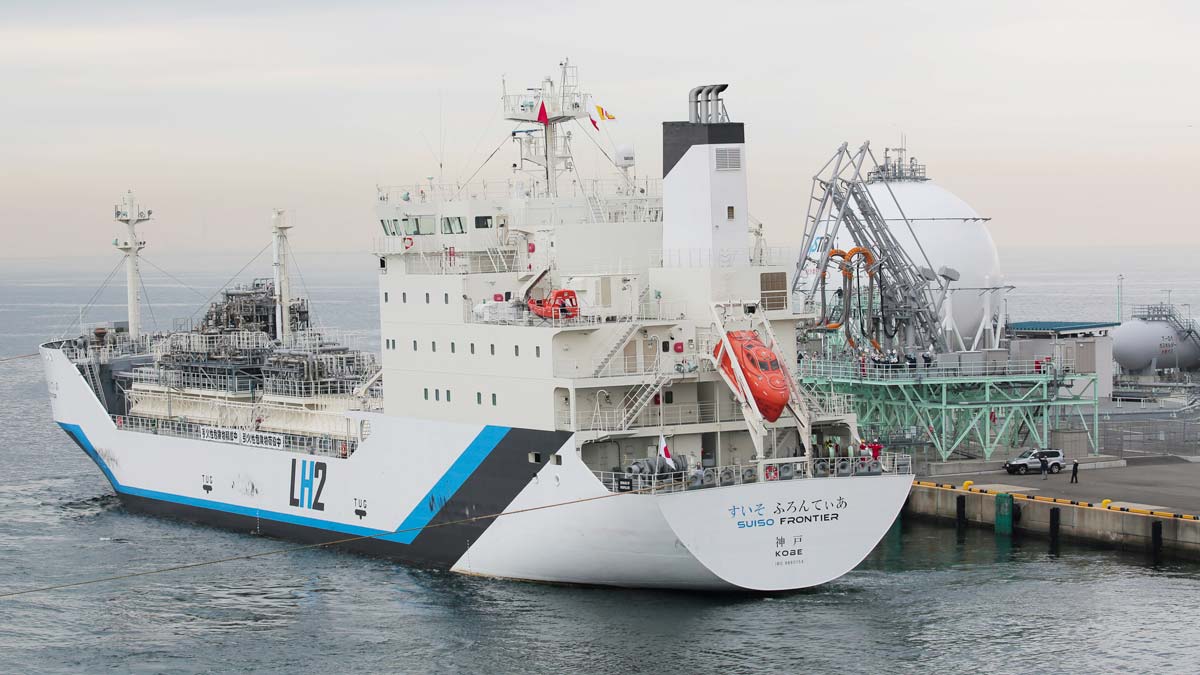Australia’s first hydrogen exports mostly consisted of conventional fossil hydrogen, with the $500 million “clean” hydrogen project supplying less than half the hydrogen used in the first landmark shipment to Japan.
Last month, the first shipment of liquid hydrogen produced by the Hydrogen Energy Supply Chain (HESC) project departed the Port of Hastings in Victoria for Japan, in what was labelled a major milestone for Australia’s burgeoning hydrogen industry.
A spokesperson for the HESC project the confirmed to RenewEconomy that the pilot shipment of hydrogen using the newly commissioned Suiso Frontier involved the transport of just 2.6 tonnes of hydrogen.
But while the Morrison Government celebrated the milestone shipment as the first exports of “clean” hydrogen to Japan, the majority of hydrogen sent to Japan was likely produced using unabated fossil fuels with just one tonne of the hydrogen used in this first shipment being produced by the HESC project.
That one tonne of hydrogen was produced using brown coal as its primary feedstock – one of the dirtiest forms of fossil fuel – with the hydrogen being made “clean” through the purchase of carbon offsets.
RenewEconomy has confirmed that the remaining 1.6 tonnes of hydrogen shipped were supplied by project partner Coregas. Representatives of the HESC project told RenewEconomy that this additional hydrogen – which makes up more than 60 per cent of the pilot hydrogen shipment – was produced from fossil gas.
The additional hydrogen supplied by Coregas was needed to ensure there was sufficient hydrogen available to allow for the loading and unloading of the hydrogen to be appropriately evaluated, with the one tonne of hydrogen produced by HESC insufficient for this purpose.
The HESC project has sought to establish a complete operating supply chain, including hydrogen production in Australia through to the receipt of liquid hydrogen to Japan, recently launching its first pilot shipment using the Suiso Frontier ship constructed by Kawasaki.
The ship has a hydrogen capacity of 1,250 cubic metres, which translates to around 88 tonnes of liquid hydrogen, and is expected to make numerous shipments of hydrogen between Australia and Japan.
While parts of the HESC project are undoubtedly highly valuable and represent a significant advance in Australia’s hydrogen export capabilities – including the construction of hydrogen liquefaction facilities and the commissioning of one of the world’s first dedicated vessels for hydrogen transport – the project has faced criticism for using brown coal as its primary source of hydrogen.
The HESC project has touted plans to incorporate carbon capture and storage capabilities with the project – a separate CarbonNet CCS facility – but that system is not yet operational.
The project has instead opted to purchase Australian Carbon Credit Units, a form of carbon offset, to account for the emissions from the brown coal consumed during the production of its one tonne of hydrogen output.
The $500 million HESC project has been promoted as a lifeline for Victoria’s brown coal reserves – with the Latrobe Valley home to around a quarter of the world’s known brown coal. These reserves face effective abandonment upon the closure of the state’s brown coal fuelled power stations.
The project is sourcing brown coal from a facility located at AGL Energy’s Loy Yang power station, with that power station expected to close by 2047, if not earlier.
With brown coal being such a poor quality source of energy – it has a very low energy content and produces very high levels of pollution compared to even black coal – there is virtually no international market for the resource.
Once the last of Victoria’s brown coal power stations close the brown coal reserves are likely to go unused as they are effectively unexportable unless an alternative use – such as its conversion into hydrogen – can be found.
But given the performance of the HESC project, which has yielded just one tonne of hydrogen despite the more than $500 million being poured into the project – including $100 million of taxpayer funds – it raises doubts about whether the project could even deliver the promised lifeline for brown coal.
Prime minister Scott Morrison lauded the project as a “milestone” for Australia’s clean hydrogen exports, using it as an opportunity to announce that the federal government would tip a further $27.5 million into the project.
“The HESC project puts Australia at the forefront of the global energy transition to lower emissions through clean hydrogen, which is a fuel of the future,” Morrison said.
One wonders why the project couldn’t have proceeded to establish the pilot supply chain infrastructure while producing the hydrogen using a renewably powered electrolyser.










